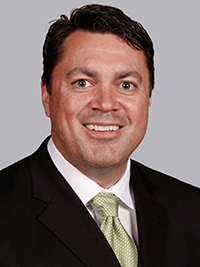iVita Financial: Reducing bad debt while improving the patient financial experience
How do you help healthcare organizations?
In this Business Profile, iVita Financial’s Greg Falconer, president, and Chris Cox, vice president product strategy, talk about how to speed collections and improve patient wellness using non-recourse lines of credit.

Ever since the advent of high deductible health plans, healthcare providers have struggled to collect patient balances, which have grown considerably due to mounting patient responsibility and rising care costs. At iVita Financial, we recognize the challenges hospitals and health systems face and have built a program that improves patient collections, accelerating cash flow and shrinking bad debt while boosting patient satisfaction and enabling a more patient-centric service experience.
The goals of our solution are to foster patient wellness while supporting financial sustainability. From a patient perspective, our interest-free lines of credit allow individuals to pay for their out-of-pocket costs more comfortably, keeping them on the path toward complete physical and financial health. Since we are a non-recourse lender, hospitals benefit in terms of improved cash flow and reduced risk.
What are some of the biggest challenges you see currently affecting healthcare organizations?

Within the revenue cycle, patients are rapidly becoming the largest payer. As individuals labor to meet their responsibilities in a timely manner, hospitals and health systems can experience cash flow delays, longer A/R days and increased bad debt. To remain sustainable, healthcare organizations should take advantage of new ways to drive patient collections. We believe patient financing is the strategy with the greatest yield.
Providers are also trying to keep up with evolving consumer expectations regarding the healthcare service experience. A similar paradigm shift occurred in banking where consumers demanded more flexibility, easier to use products and an overall better customer experience. Traditional banks couldn’t pivot fast enough, and an entirely new industry was born with the emergence of financial technology (FinTech). We anticipate the same sequence of events will occur in healthcare. As patients demand price transparency, upfront estimates, multiple payment options and intuitive digital payment tools they can use on their own time, the market for healthcare financial solutions will only expand.
How does your program help address these challenges?
Our patient financing program delivers material financial improvement over current self-pay collection rates. We give providers faster access to cash and capital, making it available within days of patient discharge. Because we are a non-recourse lender, we assume the full credit risk and will not come back to a provider in the event patients default on their loans. In addition, there is no need to hold a bad debt reserve on the balance sheet to participate in our program — something many recourse lenders require.
Not only is iVita Financial a non-recourse lender, but our lines of credit are underwritten by a federally insured financial institution with a generous underwriting standard, and this combination is something that sets us apart in the marketplace. With our program, almost any patient who has a financial need can get access to a line of credit, provided they have the means to pay it back. We don’t require FICO credit scores and don’t consider them when deciding whether to lend to a patient.
Operationally, our solution seamlessly integrates into a hospital’s revenue cycle workstream, allowing staff to offer patients financing at any access point. For example, a patient access representative can log into our system during scheduling and registration and pre-qualify a patient for enrollment in a matter of minutes. Likewise, a financial counselor who visits the patient’s room during their inpatient stay can also log into our system to prequalify patients. Finally, members of the back-end collections department can connect patients with us if an individual receives a bill that they anticipate having trouble paying. Patients can apply and manage their loan using a digital, user-friendly interface, finishing the application on their phone before even leaving the hospital. This enhanced consumer experience brings the patient peace of mind that their balance has been addressed.
Patients can add additional balances (both past and future) to their line of credit with no additional underwriting. When qualifying the patient, the registrar can look to see if the individual has previous balances to roll into the line of credit. Or the patient can use a convenient online portal to make changes. We let patients take care of new balances without having to modify their monthly out-of-pocket costs. For instance, if a patient has $2,000 on their line with a $100 per month payment, and they add an additional $500 to the line, their payment wouldn’t change. Not only is this financially beneficial for the patient, it also prevents them from avoiding future healthcare services for fear of increasing monthly costs. Our goal is to make healthcare more affordable for patients.
What are some considerations for healthcare leaders when choosing this type of program?
To start, hospital and health system leaders should define their goals for a financing program and determine which partner has an offering that best aligns with their objectives. If they want to accelerate cash flow, they should limit the risk of assuming patient loans or offer a patient-friendly program that can improve satisfaction while reducing the cost to collect.
If these hospital and health system professionals want to speed cash flow and limit bad debt, then they should consider partnering with a non-recourse lender that funds with no strings attached. Clarity around funding is important for cash management and forecasting. Some lenders are slow or wait to pay the hospital based on a patient’s repayment pattern. Find a provider that funds the balance almost immediately and does not have hidden rules or fees.
If boosting patient satisfaction is a priority, look for a program that is accessible, flexible and interest free. It should also meet the needs of as many patients as possible and not be limited to high credit profiles or other criteria.
As healthcare organizations implement use of your program into their day-to-day operations, what advice would you offer so they can best set themselves up for success?
We recommend implementing the program systemwide, weaving it into pre-service, point-of- service and post-service workflows. Hospitals can onboard the program in around 30 days, encompassing all project activities from marketing to logistics to staff training. We work with a hospital’s revenue cycle leaders to determine where the program will have the biggest impact and start from there. Some hospitals prefer to begin with pre-service workflows and work toward back-end collections. Others like to start with the billing department and work toward pre-service processes.
Note that merely implementing a patient financing program will not transform collection activities if hospital staff members are not comfortable talking with patients about their financial responsibilities. Staff should ask for payment at each step in the care process and provide estimates when available. To help our customers, we provide training scripts and recommended cues that guide the conversation and increase the staff’s comfort level around asking for money. Providers may also want to establish team and individual incentives to further prompt staff to engage in these conversations and improve patient collections.
It’s also important to consider where our program fits with existing payment plan options. There is a time and place for hospital-managed payment plans. For example, if a patient balance is $500 or less, it may make sense to put the individual on an internal payment plan or try to collect the money upfront. However, if the patient’s liability starts to go above $500, a traditional payment plan becomes much more difficult to administer. That is where our program can meet the needs of both patients and hospitals, making lines of credit available and easy to use while removing the healthcare organization from the role of managing larger loans.
How can healthcare providers learn more about your organization?
For more information about financing programs and the benefits of iVita Financial’s offering, check out the following links:
Website: ivitafinancial.com
White Paper: ivitafinancial.com/patient-financing-strategies
About iVita Financial
iVita Financial focuses on improving patient financial health and provider sustainability. Our program provides a no-interest line of credit for patients of all credit profiles, helping our partner hospitals throughout the U.S. improve cash flow and reduce patient bad debt. We help patients pay for their out-of-pocket costs, keeping them on the path toward complete physical and financial wellness.
This published piece is provided solely for informational purposes. HFMA does not endorse the published material or warrant or guarantee its accuracy. The statements and opinions by participants are those of the participants and not those of HFMA. References to commercial manufacturers, vendors, products, or services that may appear do not constitute endorsements by HFMA.






